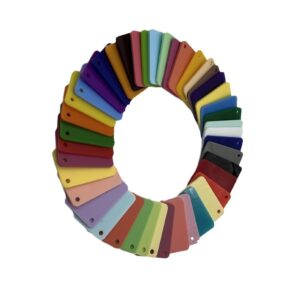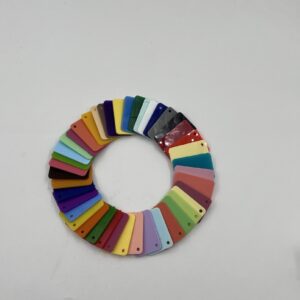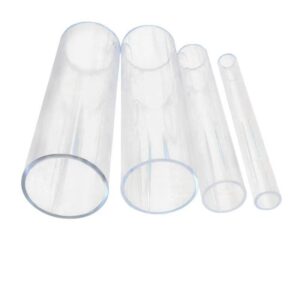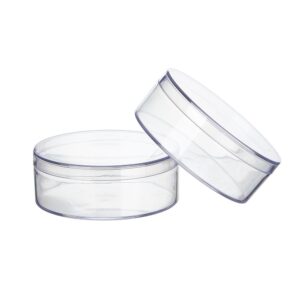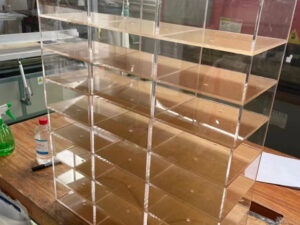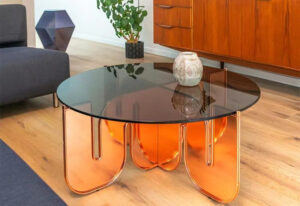Summary
Mix-and-match pairing of acrylic furniture with other materials is a burgeoning trend in contemporary interior design, celebrated for its ability to enhance both aesthetic appeal and functional versatility. Acrylic furniture, known for its durability, lightweight nature, and modern aesthetic, offers a unique opportunity to create harmonious environments when thoughtfully combined with traditional materials such as wood, metal, and wicker. This approach not only enriches interior spaces but also reflects a growing preference for personalized and eclectic design, catering to diverse tastes and styles across various settings.
The notable versatility of acrylic allows it to be molded into various shapes and sizes, making it suitable for a wide range of applications from coffee tables to shelving units. Its transparent quality provides a sense of spaciousness and lightness, which is particularly beneficial in smaller areas. When paired with materials like wood, the warmth and texture of the latter beautifully contrast with the sleekness of acrylic, while metal elements can introduce an industrial elegance, amplifying the overall design sophistication. Additionally, incorporating wicker softens the sleek aesthetic of acrylic, creating inviting and comfortable environments, particularly in outdoor settings.
Despite its many advantages, the trend also presents design challenges. Ensuring a cohesive color palette and maintaining visual balance are crucial for achieving a harmonious integration of acrylic with other materials. Designers often experiment with various textures and finishes to avoid overwhelming spaces with too many contrasting elements, fostering a sense of unity throughout the decor. As consumer preferences lean towards bespoke and customizable solutions, the collaboration between acrylic and traditional materials continues to evolve, inviting innovation and creativity in furniture design.
As this trend continues to gain momentum, it showcases the potential of acrylic to transform both residential and commercial spaces. Its integration with diverse materials not only caters to functional needs but also contributes to a sophisticated narrative that resonates with modern aesthetics, ultimately redefining how individuals express their personal style through interior design.
Table of Contents
Characteristics of Acrylic Furniture
Acrylic furniture is renowned for its unique blend of aesthetic appeal and functional advantages, making it a popular choice in contemporary interior design.
Durability and Maintenance
Acrylic is celebrated for its durability and long lifespan, requiring minimal upkeep to maintain its appearance over time. Unlike traditional materials, acrylic does not absorb moisture, making it an excellent choice for humid climates. Its lightweight nature also facilitates easy rearrangement and mobility, catering to those who appreciate flexibility in their living spaces.
Aesthetic Appeal
Acrylic furniture offers a sleek, modern look that can seamlessly complement various interior styles, from minimalistic to eclectic. Its transparent quality creates an illusion of space, allowing it to harmonize with other materials while enhancing light within a room. Available in a variety of finishes—clear, frosted, or tinted—acrylic furniture can be customized to align with specific decor themes, adding a touch of sophistication to any setting.
Versatility
One of the most notable characteristics of acrylic furniture is its versatility. It can be molded into numerous shapes and sizes, suitable for a wide range of applications, including coffee tables, chairs, shelving units, and office desks. This adaptability makes it ideal for both small and large spaces, as its see-through quality helps prevent the area from feeling cluttered.
Cost-Effectiveness
In addition to its aesthetic and practical advantages, acrylic furniture is often more budget-friendly compared to high-end materials like glass or metal. This affordability, combined with its low maintenance requirements, makes it an attractive option for homeowners looking to elevate their interiors without incurring significant expenses.
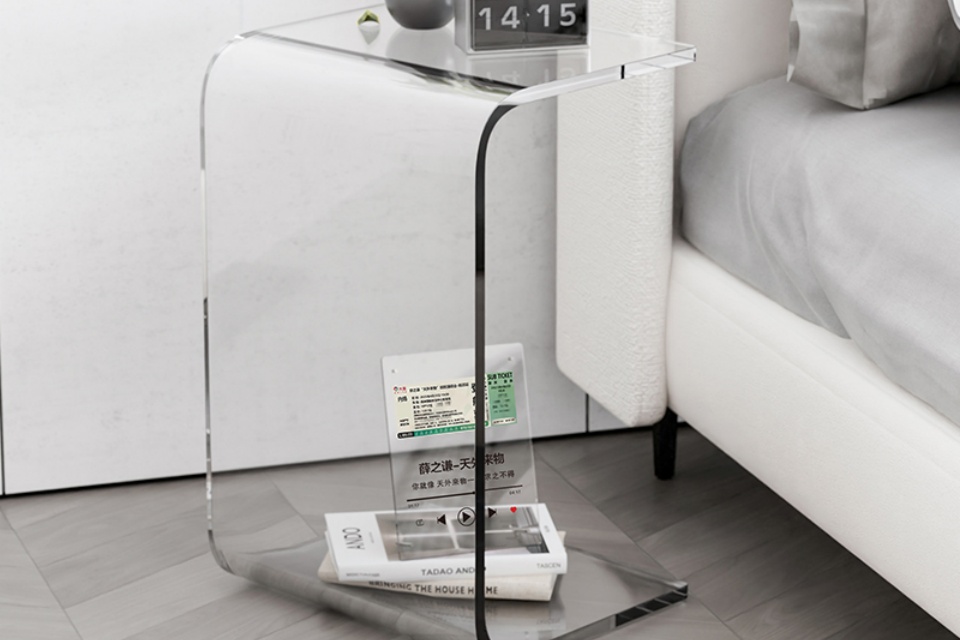
Complementary Materials
Mixing acrylic furniture with other materials can significantly enhance the aesthetic and functional qualities of a space. When paired thoughtfully with materials such as wood, metal, and wicker, acrylic can contribute to a harmonious and stylish design.
Wood
Acrylic and wood complement each other beautifully, especially in high-end or boutique settings. The warm, natural feel of wood pairs well with the modern transparency of acrylic, creating an inviting atmosphere while maintaining a contemporary edge. Moreover, the structural properties of wood provide a solid foundation that can enhance the overall stability of acrylic pieces, allowing for complex designs that are both visually appealing and durable.
Metal
The combination of acrylic and metal is particularly effective in creating an industrial yet luxurious aesthetic. Metal accents can either highlight the sleekness of acrylic or add a touch of elegance, depending on the finish chosen. This pairing is beneficial not only for its visual contrast but also for the enhanced durability it offers; metal provides structural strength, while acrylic adds a lightweight and modern feel. The interplay between these materials fosters depth and sophistication in various design styles, ranging from contemporary to eclectic.
Wicker
Incorporating wicker with acrylic furniture introduces a softer, more textured element that balances the sleekness of acrylic. Wicker’s organic and tactile nature provides a warm contrast, making spaces feel more inviting. The combination can create a harmonious outdoor setting, where the durability of acrylic withstands weather elements, while wicker adds a touch of comfort and charm. This thoughtful mixing of materials enhances the overall aesthetic appeal of outdoor and indoor spaces alike.
By understanding how these materials interact and complement each other, designers can create cohesive, functional, and aesthetically pleasing environments that resonate with both comfort and modernity.
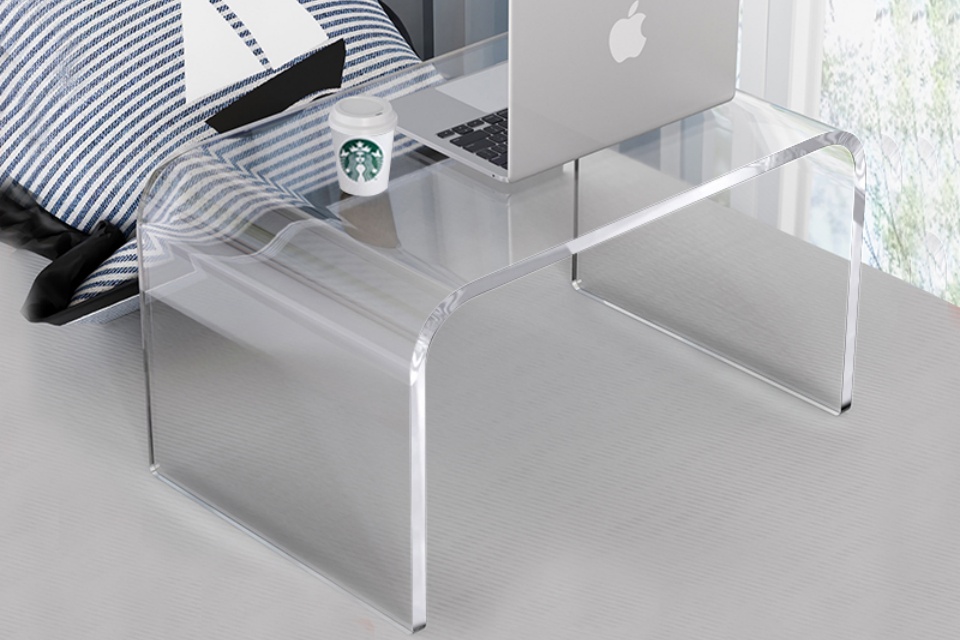
Design Considerations
When integrating acrylic furniture with other materials, several design considerations should be taken into account to achieve a harmonious and visually appealing space.
Material Mixing
Acrylic can effectively complement traditional materials such as wood and metal, enhancing both aesthetics and functionality. Mixing polished and rough surfaces can create a more dynamic design; for example, pairing a natural wood table with matte black metal chairs balances rustic and modern elements. The versatility of acrylic allows it to serve as an accent piece, contributing visual lightness and clarity to a space dominated by heavier materials like wood or metal.
Consistent Color Palette
Maintaining a cohesive color palette is crucial when mixing materials. This approach ensures unity and coherence throughout the design. For instance, a Scandinavian-inspired look can be achieved by using light wood and neutral-toned metals, while a more sophisticated ambiance may be created with dark wood and gold metal accents. When integrating acrylic furniture, consider its transparent qualities, which can help reflect and amplify the colors of surrounding materials.
Visual Balance
To avoid overwhelming a space with too many contrasting materials, attention to visual balance is essential. If wood is a dominant feature in a room, using acrylic for tables can introduce a sense of lightness without adding visual heaviness. Creating a mood board can aid in visualizing how various materials, colors, and textures will interact, facilitating a more harmonious design process.
Space Considerations
The type of space should influence the choice of materials. For example, acrylic’s transparent nature can enhance the feeling of spaciousness, making it ideal for smaller areas where light is a concern. By allowing natural light to filter through, acrylic furniture reduces the need for artificial lighting, promoting a more airy and open atmosphere.
Textural Contrast
Incorporating a mix of textures is another effective strategy for enhancing design depth. Combining softer materials, like fabric cushions, with the sleekness of acrylic can create an interesting contrast that elevates the overall design. Additionally, layering furniture of varying heights, such as a low acrylic coffee table alongside taller metal side tables, can keep the visual flow engaging and dynamic.
By thoughtfully considering these design elements, the integration of acrylic furniture with other materials can result in a sophisticated, balanced, and unique interior space.
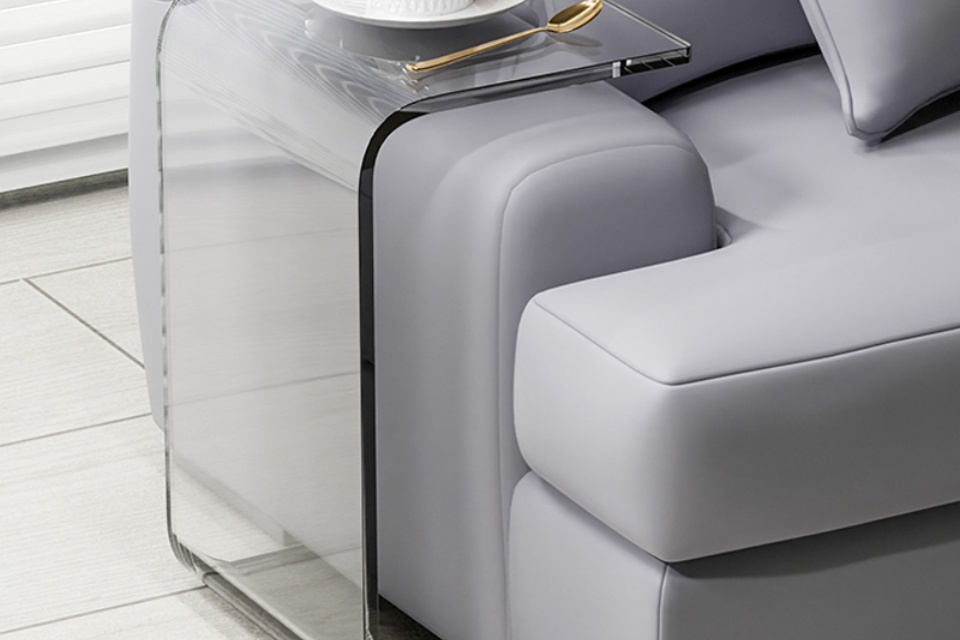
Popular Applications
Integration of Acrylic with Traditional Designs
Acrylic furniture is increasingly being combined with traditional designs, resulting in a sophisticated blend of modern and classic aesthetics. Popular pieces, such as the Edinburgh Cocktail Table and the Washington Dining Table, showcase this trend, appealing to those who appreciate a timeless look with a contemporary twist. Designers are also fabricating upholstered pieces featuring acrylic elements, which provide a touch of glam while maintaining warmth and comfort.
Functional and Decorative Uses
Acrylic’s versatility allows it to be utilized in various functional and decorative applications. This includes acrylic coffee tables, which are known for their sleek and minimalist designs, making them suitable for diverse interior styles. Additionally, acrylic display cases serve as excellent options for retail stores and museums, showcasing products without visual distractions. Other popular applications include acrylic chairs and stools, providing chic yet sturdy seating solutions, and floating acrylic shelving units that add a modern touch to storage needs.
Customization and Personalization
The demand for customizable acrylic furniture has risen, as designers increasingly collaborate with clients to create unique pieces tailored to individual tastes. This trend allows for the integration of other materials, such as wood or marble, into acrylic designs, enhancing their aesthetic appeal and functionality. Such adaptability not only meets the growing desire for personalized furnishings but also elevates the overall design experience.
Blending with Various Materials
Mixing acrylic with materials like wood, metal, and wicker can create balanced and inviting outdoor spaces. For instance, pairing acrylic elements with wooden frames offers a blend of natural beauty and modern sophistication, while incorporating wicker adds comfort and a relaxed vibe. This approach enables designers to harness the best qualities of each material, resulting in a cohesive and functional outdoor environment that resonates with personal style and practical needs.
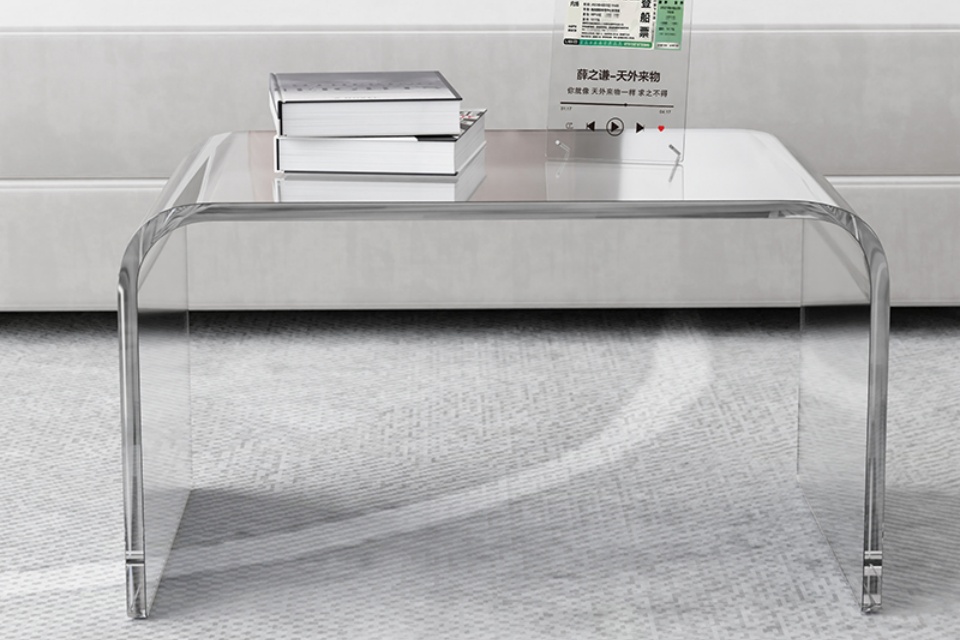
Trends in Mix-and-Match Pairing
The trend of mixing and matching acrylic furniture with various materials has gained significant popularity in contemporary interior design. This approach not only enhances aesthetic appeal but also allows for greater versatility and personalization in home decor.
Return to Traditional Designs
Recent years have seen a resurgence in demand for traditional furniture designs that incorporate acrylic elements. Classic pieces, such as the Edinburgh Cocktail Table and the Bella Chair, have remained favorites, showcasing a blend of modern material with timeless styles. Designers are increasingly gravitating towards these traditional aesthetics, often integrating acrylic with more conventional materials like wood and metal to create striking contrasts that resonate well within classic and modern spaces alike.
Eclectic and Customizable Styles
The modern design ethos embraces eclecticism, encouraging the combination of diverse styles and materials. This trend allows designers to customize acrylic pieces, altering dimensions and incorporating elements like marble or wood to achieve a personalized look. This shift towards customization reflects a broader industry trend where clients are becoming more patient with lead times, indicating a willingness to invest in unique, tailored furniture solutions.
Mixing Materials for Visual Interest
Contemporary interior design increasingly favors the balanced integration of different textures and finishes. Designers are encouraged to experiment by pairing acrylic furniture with materials such as wood, metal, and even natural fibers like rattan, which enriches the overall aesthetic and adds depth to the design. This technique not only breaks the monotony of uniform spaces but also brings a sense of visual and sensory richness to interiors.
Influence of Digital Fabrication
The rise of digital fabrication techniques, including CNC machining and 3D printing, has revolutionized how acrylic furniture is designed and produced. This technological advancement allows for the creation of customizable pieces that cater to modern consumer demands, enabling intricate designs that can incorporate various materials seamlessly. Designers like Jasper Morrison exemplify this integration of technology and design, setting new standards for creativity in the industry.
Future Trends
Looking ahead, the mix-and-match pairing of acrylic furniture with other materials is expected to continue evolving. Trends indicate a growing inclination towards playful organic shapes and minimalist lines that incorporate metallic accents, further enhancing the dynamic interplay between acrylic and traditional materials. As the furniture design landscape shifts, embracing these innovative combinations will allow designers to create spaces that are not only functional but also deeply personal and reflective of individual styles.
Case Studies and Examples
Residential Interiors
In residential settings, acrylic furniture is often utilized to enhance the perception of space and light. For example, the Transparent Collection by designer Nendo features glossy color panels that can be integrated with wood and metal, creating a striking juxtaposition that adds depth and interest to living areas. Designers frequently recommend combining acrylic pieces with natural materials to achieve a harmonious balance; this method allows for a contemporary interpretation while retaining warmth and texture from wood.
Commercial Spaces
Acrylic furniture has also gained traction in commercial environments, such as restaurants and hotels, where its sleek aesthetic complements modern design elements. Acrylic wall panels, for instance, are employed to create artistic feature walls that can be backlit, enhancing ambiance and providing a sophisticated focal point in upscale venues. These panels not only elevate the decor but also demonstrate the material’s versatility when paired with metals and glass, catering to the need for both functionality and style.
Design Exhibitions
Trade shows often showcase innovative uses of acrylic furniture, highlighting its adaptability in various contexts. Designers like Masha Osorio have created pieces that blur the lines between furniture and art, emphasizing the material’s capacity for creative expression. Such exhibitions serve as inspiration for professionals seeking to explore acrylic’s potential in their projects, allowing them to envision how it can complement existing design elements and contribute to a cohesive aesthetic.
Custom Fabrication Projects
In custom fabrication projects, acrylic is frequently combined with wood and metal to produce unique furniture pieces tailored to specific client needs. This approach offers designers the flexibility to incorporate diverse styles while ensuring that the final products meet aesthetic goals and functionality requirements. For example, using acrylic alongside other materials can create a visually striking effect, as seen in various collaborative projects where artisans and clients work together to reflect individual tastes and preferences.
These case studies illustrate the myriad ways acrylic furniture can be effectively paired with other materials to create sophisticated, modern, and functional spaces in both residential and commercial settings.





